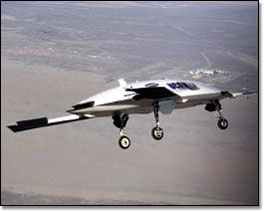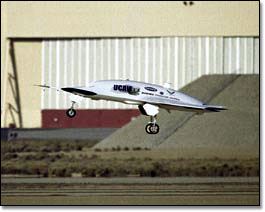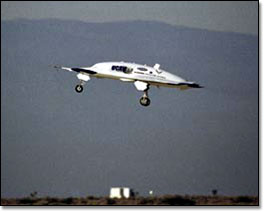| X-45A makes HISTORY
Successful first flight at Dryden paves
the way for more tests, more UCAVs
BY WILLIAM COLE

 The
Boeing X-45A Unmanned Combat Air Vehicle took to the skies May 22 above
the Mojave Desert, marking the maiden flight of the world’s first
such plane built specifically for combat. The
Boeing X-45A Unmanned Combat Air Vehicle took to the skies May 22 above
the Mojave Desert, marking the maiden flight of the world’s first
such plane built specifically for combat.
The successful flight of the X-45A technology demonstrator clears the
way for further testing, new refinements and a larger, more capable B-model
already under development.
The X-45A has a stealthy, tailless airframe with a 34-foot wingspan. It
weighs 8,000 pounds empty and will carry a variety of precision strike
munitions including the Small Diameter Bomb and the GPS-guided Joint Direct
Attack Munition. Other smaller unmanned air vehicles, which have been
flown operationally in military operations in Bosnia-Herzegovina, Afghanistan
and elsewhere, were originally designed for surveillance and later adapted
to carry weapons.
Boeing Phantom Works and Military Aircraft and Missile Systems’ Unmanned
Systems organization are developing UCAV for the U.S. Defense Advanced
Research Projects Agency and the U.S. Air Force.
 U.S.
Air Force Col. Mike Leahy, UCAV program manager for DARPA, likened the
test flight to “one lap around the Indy 500.” The aircraft,
he said, was “rock solid and stable all the way through.” U.S.
Air Force Col. Mike Leahy, UCAV program manager for DARPA, likened the
test flight to “one lap around the Indy 500.” The aircraft,
he said, was “rock solid and stable all the way through.”
“This flight represents a significant jump in our quest to mature
the technologies, processes and system attributes required to integrate
UCAVs into the future Air Force,” Leahy said. “UCAVs will effectively
and affordably perform extremely hazardous missions, such as the suppression
of enemy air defenses, while greatly reducing the risk our aircrews have
to face.”
Later this year, a second X-45A will begin flying, leading to the start
of flight-test demonstrations of multiple aircraft next year.
Those coordinated flight tests are the technical heart of the program
and the key to unlocking the potential of this revolutionary weapon system,
Leahy said.
 Further
testing will continue to explore the boundaries of intelligent unmanned
combat operations, culminating in fiscal 2006 with UCAVs and manned aircraft
operating together during an exercise. Further
testing will continue to explore the boundaries of intelligent unmanned
combat operations, culminating in fiscal 2006 with UCAVs and manned aircraft
operating together during an exercise.
The operational UCAV system concept will be refined in parallel with X-45A
flight testing, Leahy said.
The X-45B fieldable prototype, now under development, will be larger and
more capable than its predecessors. It will lay the foundation for an
initial operational system toward the end of this decade.
In addition to the DARPA/Air Force UCAV, Boeing is developing a concept
for the DARPA/U.S. Navy UCAV-N program. The company envisions a significant
amount of subsystem and software commonality between the two programs,
an arrangement that could reduce cost and risk associated with both efforts.
|
Ecstatic
crowd watches a ‘flawless’ flight
“It’s in the air!”
The message rippled through the crowd and soon turned to cheers and
applause as the Unmanned Combat Air Vehicle technology-demonstration
aircraft took to the sky over the Mojave Desert in Southern California
— and made aerospace history.
It was the first time that the X-45A, a 27-foot-long aircraft designed
specifically for combat, had flown. The U.S. Air Force described the
test flight as “flawless,” and Boeing characterized it as
a “wonderful milestone.”
The success of the first flight of the X-45A was especially savored
by the invited onlookers around the Rogers Dry Lakebed at NASA Dryden
Flight Research Center at Edwards Air Force Base, Calif.
They had been waiting with growing anticipation for more than four
days because of weather-related delays. Continuing winds had caused
the team to postpone the flight twice.
Finally, on May 22, the aircraft and the team were ready. Fourteen
minutes after takeoff, the sleek, white, unmanned aircraft was back
on the ground.
Boeing program manager Rich Alldredge said the flight went exactly
as the team had expected and seen in many simulations.
With its landing gear down throughout the flight, the aircraft reached
airspeed of 195 knots and an altitude of 7,500 feet, and essentially
did a systems check. The craft’s bank angle never exceeded 20
degrees, said Alldredge. Flight characteristics and basic aspects
of aircraft operations, particularly the command and control link
between the aircraft and the mission-control station, were successfully
demonstrated.
“This flight is a wonderful milestone for our UCAV team, every
member of which I want to thank,” said Alldredge. “DARPA,
the Air Force, NASA and Boeing together are making UCAV a tremendous
success.” |
|